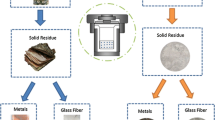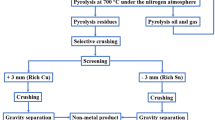Abstract
Electrical and electronic waste is a significant problem threatening countries’ economic, social, and environmental aspects. Electrical waste is toxic but contains valuable substances. With the increasing consumption of electronic devices, large amounts of this waste are generated worldwide. Due to the appearance of poisonous and precious metals in electronic waste, the management policy is different from traditional waste management. Therefore, knowing more about new methods and combining them is necessary. Various methods have been developed to extract these metals, but extraction with carbon dioxide has received particular attention due to its environmental friendliness. This study aimed to increase the extraction efficiency of silver using supercritical carbon dioxide from computer printed circuit boards waste. The use of supercritical water pretreatment was applied to such wastes to enhance the concentration of silver and remove organic matter. Six experiments at the pressure of 250 bar), the temperature of 350–450 °C, and the residence time of 15–45 min were conducted. The pressure of 230 bar, the temperature of 400 °C, and the retention time of 45 min were selected as the optimal point for supercritical water oxidation conditions. Pretreated solids were used as feed for the supercritical carbon dioxide extraction process. Optimal test conditions include the pressure of 217 bar, the temperature of 51 °C, and the residence time of 40 min. The extraction of silver from the residues of printed circuit boards in optimal situations reached 98% without solvents and ligands, which is selected as the best extraction point.






Similar content being viewed by others
Notes
light-emitting diode (LED).
Inductively coupled plasma (ICP).
References
Abdelbasir SM, Hassan SS, Kamel AH, El-Nasr RS (2018) Status of electronic waste recycling techniques: a review. Environ Sci Pollut Res 25:16533–16547
Ahirwar R, Tripathi AK (2021) E-waste management: A review of recycling process, environmental and occupational health hazards, and potential solutions. Environ Nanotechnol Monit Manage 15:100409
Baxter J, Lyng K-A, Askham C, Hanssen OJ (2016) High-quality collection and disposal of WEEE: environmental impacts and resultant issues. Waste Manage 57:17–26
Chatterjee S (2012) Sustainable electronic waste management and recycling process. Am J Environ Eng 2:23–33
Fayaz SM, Abdoli MA, Baghdadi M & Karbasi A (2020) Ag removal from e-waste using supercritical fluid: improving efficiency and selectivity. Int J Environ Stud, 1–15
Ghosh B, Ghosh M, Parhi P, Mukherjee P, Mishra B (2015) Waste printed circuit boards recycling: an extensive assessment of current status. J Clean Prod 94:5–19
Golzary A, Abdoli MA (2020) Recycling of copper from waste printed circuit boards by modified supercritical carbon dioxide combined with supercritical water pre-treatment. J CO2 Utilization 41:101265
Goosey M, Kellner R (2002) A scoping study end-of-life printed circuit boards. Intellect and the Department of Trade and Industry, Makati City
Guo J, Guo J, Xu Z (2009) Recycling of non-metallic fractions from waste printed circuit boards: a review. J Hazard Mater 168:567–590
Huang H, Cai C, Yu S, Li X, Liu Y, Tao S, Liu W (2019) Emission behaviors of nitro-and oxy-polycyclic aromatic hydrocarbons during pyrolytic disposal of electronic wastes. Chemosphere 222:267–274
Iannicelli-Zubiani EM, Giani MI, Recanati F, Dotelli G, Puricelli S, Cristiani C (2017) Environmental impacts of a hydrometallurgical process for electronic waste treatment: a life cycle assessment case study. J Clean Prod 140:1204–1216
Islam A, Ahmed T, Awual MR, Rahman A, Sultana M, ABD AZIZ A, MONIR MU, TEO SH, HASAN M (2020) Advances in sustainable approaches to recover metals from e-waste-a review. J Clean Prod 244:118815
Ismail H, Hanafiah MM (2020) A review of sustainable e-waste generation and management: present and future perspectives. J Environ Manag 264:110495
JANG Y-C (2010) Waste electrical and electronic equipment (WEEE) management in Korea: generation, collection, and recycling systems. J Mater Cycles Waste Manage 12:283–294
KAYA M (2016) Recovery of metals and nonmetals from electronic waste by physical and chemical recycling processes. Waste Manage 57:64–90
Khaliq A, Rhamdhani MA, Brooks G, Masood S (2014) Metal extraction processes for electronic waste and existing industrial routes: a review and Australian perspective. Resources 3:152–179
KWOK R (2019) Inner workings: how bacteria could help recycle electronic waste. Proc Natl Acad Sci 116:711–713
Li K, Xu Z (2019) A review of current progress of supercritical fluid technologies for e-waste treatment. J Clean Prod 227:794–809
Li K, Xu Z (2021) Decomposition of high-impact polystyrene resin in e-waste by supercritical water oxidation process with debromination of decabromodiphenyl ethane and recovery of antimony trioxide simultaneously. J Hazard Mater 402:123684
Liu K, Zhang Z, Zhang F-S (2016) Direct extraction of palladium and silver from waste printed circuit boards powder by supercritical fluids oxidation-extraction process. J Hazard Mater 318:216–223
Niu B, Chen Z, Xu Z (2017) Recovery of tantalum from waste tantalum capacitors by supercritical water treatment. ACS Sustain Chem Eng 5:4421–4428
Parajuly K, Fitzpatrick C, Muldoon O, Kuehr R (2020) Behavioral change for the circular economy: a review with focus on electronic waste management in the EU. Resour Conserv Recycl: X 6:100035
Park YJ, Fray DJ (2009) Recovery of high purity precious metals from printed circuit boards. J Hazard Mater 164:1152–1158
Pekarkova Z, Williams ID, Emery L, Bone R (2021) Economic and climate impacts from the incorrect disposal of WEEE. Resour Conserv Recycl 168:105470
Petrov S, Ibragimova D, Safiulina A, Vakhin A, Okekwe R, Karalin E (2017) Conversion of organic matter in the carbonaceous medium in the supercritical water. J Petrol Sci Eng 159:497–505
Sahajwalla V, Gaikwad V (2018) The present and future of e-waste plastics recycling. Curr Opin Green Sustain Chem 13:102–107
Sethurajan M, van Hullebusch ED, Fontana D, Akcil A, Deveci H, Batinic B, Leal JP, Gasche TA, Ali Kucuker M, Kuchta K (2019) Recent advances on hydrometallurgical recovery of critical and precious elements from end of life electronic wastes-a review. Crit Rev Environ Sci Technol 49:212–275
Shuey S, Taylor P (2005) Review of pyrometallurgical treatment of electronic scrap. Min Eng 57:67–70
SUM EY (1991) The recovery of metals from electronic scrap. Jom 43:53–61
Tuncuk A, Stazi V, Akcil A, Yazici EY, Deveci H (2012) Aqueous metal recovery techniques from e-scrap: hydrometallurgy in recycling. Miner Eng 25:28–37
Wang R, Xu Z (2014) Recycling of non-metallic fractions from waste electrical and electronic equipment (WEEE): a review. Waste Manage 34:1455–1469
Willner J, Fornalczyk A (2013) Extraction of metals from electronic waste by bacterial leaching. Environ Prot Eng 39:197–208
Yamane LH, de Moraes VT, Espinosa DCR, Tenório JAS (2011) Recycling of WEEE: Characterization of spent printed circuit boards from mobile phones and computers. Waste Manage 31:2553–2558
Yang T, Xu Z, Wen J, Yang L (2009) Factors influencing bioleaching copper from waste printed circuit boards by Acidithiobacillus ferrooxidans. Hydrometallurgy 97:29–32
Zhang L, Pradeep T, Licence P, Subramaniam B, Allen DT (2021) ACS sustainable chemistry & engineering welcomes manuscripts on advanced E-waste recycling. ACS Publ 9(10):3624–3625
Author information
Authors and Affiliations
Corresponding author
Ethics declarations
Conflict of interest
The authors declare that they have no conflict of interest.
Additional information
Editorial Responsibility: Samareh Mirkia.
Rights and permissions
About this article
Cite this article
Fayaz, S.M., Abdoli, M.A., Baghdadi, M. et al. Extraction of silver from computer printed circuit boards wastes by supercritical fluids: pretreatment study. Int. J. Environ. Sci. Technol. 19, 4883–4890 (2022). https://doi.org/10.1007/s13762-021-03679-3
Received:
Revised:
Accepted:
Published:
Issue Date:
DOI: https://doi.org/10.1007/s13762-021-03679-3




